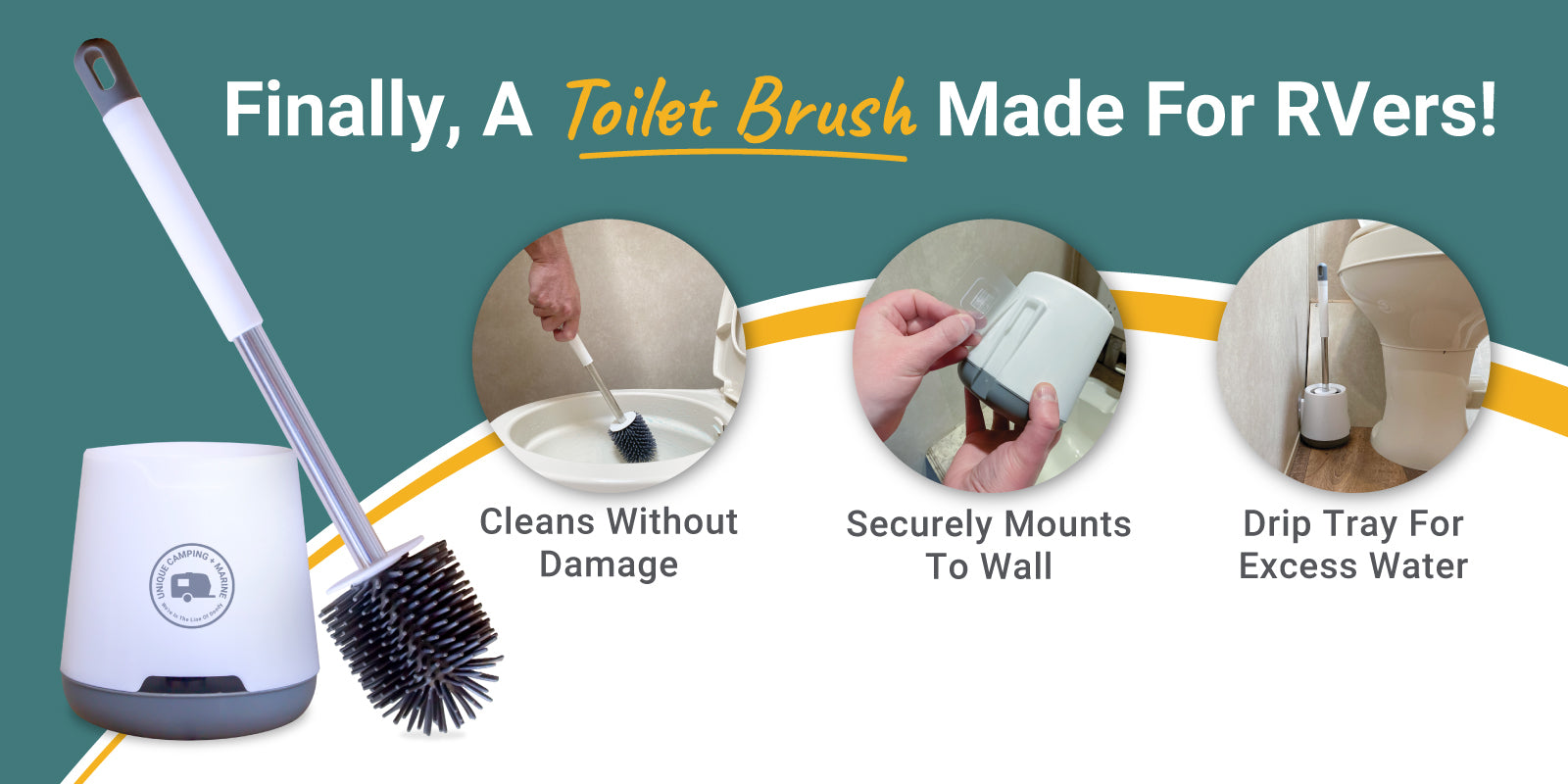Keeping your RV gray water holding tank open while at a campsite? You may want to consider adding a p-trap to your sewer discharge hose, following these step-by-step instructions.
Key Points:
- Contrary to popular belief, gray tank valves can be left open when camping on full hookups. Remember, your black tank valve should never be left open as it will result in pyramid plugs!
- Utilizing p-traps in your RV sewer discharge hose can help control odors when camping on hookups with your gray tank valve open.
- These sewer hose p-traps are easy to set up, requiring only your RV discharge hose and a means of elevating the hose.
- Proper p-trap setup is key to your discharge hose’s performance. Make sure the dip in the hose is deep enough to fully fill with liquid, so that the trap blocks noxious and potentially dangerous sewer gasses like methane from freely traveling between the campground septic system and your gray holding tank.
Whether you’re already battling odors in your RV or simply trying to prevent a stinky situation, we’re guessing that your RV sewer system is frequently front and center in your mind.
Keep in mind that if you are boondocking or not connected to hookups, you should keep your valves closed at all times, so this guide won’t apply. Instead, you’ll want to check out our guide on Treating Your RV Holding Tanks While Dry Camping.
But what about when your RV sewer discharge hose is hooked up to the campground septic system? Are there strategies that may help reduce odors and risks from noxious sewer gasses when your galley tank or gray water tank valve is left open to the campground sewer hookup? Then this guide is for you!

How P-Traps Help Prevent Odors Inside Your RV
We’ve seen p-trap spelled in creative ways on the internet, including “ptrap” and “pee trap.” Fortunately, a p-trap’s purpose is much more straightforward than figuring out its spelling! This simple piece of plumbing is named after its shape, which looks like a “p” that’s been tipped on its side, with the bend in the pipe “trapping” water to create a barrier between drains and sewer gasses.

You’ve probably noticed your RV sink’s p-trap located under the countertop. It’s great for catching jewelry that accidentally falls down the drain, but that’s not a p-trap’s primary purpose, which is to stop odors from seeping up from the gray water tank. If you’ve ever had to remove a p-trap to retrieve a lost earring that accidentally slid down the drain, then you’ve experienced the terrible smells that lurk on the other side of this simple water barrier!

A p-trap in your RV discharge hose works the same way. If you’re like many RVers who leave their galley tank or gray tank valve open when at a full hookup campsite, adding a p-trap to your discharge hose can help create an extra layer of odor protection. Note: We recommend keeping your black holding tank valve closed unless you are dumping your tanks, even when at a full hookup site.
Guide: Black Holding Tank Guidelines
Fortunately, it’s easy to set up a sewer hose p-trap, but you’ll want to start by assessing whether you would benefit from adding this tool to your odor control toolbox. Our guide has you covered!
Is Sewer Gas Seeping Up Into Your RV?
Keeping your gray water tank valve open when hooked up to the campground septic system is convenient, for sure. But how do you know if this practice may be causing odors inside or outside your RV?
When you keep your gray holding tank valve open without a p-trap in your discharge hose, it creates a two-way highway that allows the free flow of gray water out of your RV down into the sewer drain, but also makes an open air pathway between your RV and the campground septic system.
Sewer gasses are more dense than air which means they should stay down in the main sewer, but there’s a chance that air pressure in the campground septic system can push these smelly gasses up your discharge hose and into your gray tank. These noxious sewer gasses often smell like grease or garlic, not always like poop or urine, providing an important clue that you may be experiencing sewer gas seeping into your RV or coming up out of your gray tank vent pipe. Even more worryingly, these same sewer gasses may also include methane, an odorless, colorless, flammable gas that can cause methane gas poisoning.
Of course, your sink, shower and appliance p-traps should stop the majority of odors from coming up via your gray tanks as long as they have liquid in them – after all, that’s what those p-traps are designed for! While these p-traps are highly efficient, they’re not fail-safe. For example, you may have a shower in your fifth wheel that you never use. Over time, that shower drain and p-trap will likely dry out, removing the odor barrier that prevents gray tank smells from coming up into your living space. This is one reason why you may want to add another p-trap down the line between your RV and the campground septic system. This discharge hose p-trap offers an additional layer of protection in your sewer system odor control when keeping your gray holding tank valve open.
Pros and Cons of an RV Sewer Discharge Hose P-Trap
Advantages of adding a p-trap to your RV discharge hose:
- Creates an additional layer of protection in your odor control system.
- Helps prevent campground sewer smells from backing up into your gray water holding tank and coming out your tank vent.
- May help prevent drain flies and other insects from coming up the sewer discharge hose into your gray water holding tank.
Disadvantages of an RV discharge hose p-trap:
- Does not offer benefits if you routinely keep your gray tank valve closed, only opening it to dump. In this case, your closed gray tank valve is creating the barrier between the campground sewer and your camper.
- Requires space beside your RV to create the p-trap and downward slope to be effective.
- Your P-trap should adhere to campground rules and regulations, which may take extra work. Some places require that all parts of the RV discharge hose, including the p-trap, are elevated above the ground.
Keep in mind that your sewer discharge hose is only one piece of your RV sewer management system. When you apply The Unique Method to your RV black water and gray water tanks, you can eliminate virtually every wastewater problem that might pop up from the drain to the dumping station.
Step-By-Step Guide To Set Up an RV Discharge Hose P-Trap
- Before getting started, check the campground rules for sewer drainage hose requirements. For example, some sites prohibit any part of the hose from touching the ground.
- Put on disposable gloves, a good practice for every time you handle your sewer discharge hose!
- If you just arrived at your campsite, set up your RV sewer hose support between your camper and the sewer port. That support could be a commercial slinky or a homemade RV sewer hose support made from logs, bricks or other materials. Regardless of what you’re using, the support should be able to keep the sewer discharge hose off the ground, reducing wear and tear while creating a downward slope toward the sewer hookup, putting gravity to work in your favor.

- Once your support is set up, you can add your RV sewer discharge hose, leaving slack in the hose next to the RV, which is where you make the “P” part of the trap.
- Create the dropped part of the hose – the top of the “P” should dip fully below the other hose so that it will fill with water.

- To ensure you have a good barrier, we suggest filling the p-trap section with water before hooking up to your discharge port. Pour half a gallon of water (8 cups) into the hose end closest to your RV.

- Alternately, you can go ahead and hook up to the main sewer, then open your gray tank valve and run water in your sink until you’re certain that water has filled the trap.
- Once your RV sewer hose p-trap is set up, proceed using your plumbing as you normally would while on a campground septic hookup, leaving your gray water holding tank open.
- When it comes time to dump your black water holding tank, you’ll want to fill your gray tank up with water (if you have left your gray tank valve in the "open" position) so you can rinse out your discharge lines after you dump your black tank. You can do this by rapidly filling your gray tank right before dumping your black tank, or you can simply close your gray tank several hours before you intend to dump your black tank and let it fill naturally. Now that you're ready to dump your black tank, remove the p-trap from the sewer discharge hose:
- If you plan on staying at your current campsite spot, remove the p-trap by straightening the hose before doing your holding tank cleanout chores. Once you’ve finished dumping and flushing your tanks, follow the steps above to add the p-trap back to the RV discharge hose, priming it by adding water before attaching the hose to your holding tank discharge port.
- If you plan on leaving the site and traveling back home or to a new location, we suggest removing the p-trap before dumping, and then lifting the end of the discharge hose from the RV and holding that end up high to allow all of the water and waste to drain into the campground septic system before packing the hose up.
Looking for more tips on cleaning out your wastewater tanks? Check out our guide, How to Dump Your Black and Gray Water Tanks.

Review
If you’re an RVer who keeps your gray water holding tank continuously open at campgrounds, adding a p-trap to your RV sewer discharge hose may provide an additional layer of odor protection while also helping to reduce drain flies migrating from the campground sewer up into your sink and shower drains.
- RV sewer discharge hose p-traps work best for setups where the gray water tanks are always left open to the campground sewer, a setup that many RVers find to be convenient.
- The water barrier created by a discharge hose p-trap can help prevent smells and dangerous noxious gasses like methane from coming up out of the sewer and into your living space. This simple p-trap may also help block sewer flies from traveling up into your gray tank.
- When setting up a p-trap in your discharge hose, make sure the dip in the hose (the sideways “p”) is completely below the other hose level so that it can fill with water, creating a full barrier.
Understanding how your RV p-traps work can make a world of difference when it comes to managing odors. While an RV discharge hose p-trap may not be the right solution for everyone, many people have found it to work well when keeping their gray water tanks open to the campground septic system.
Of course, p-traps are only one piece of the puzzle when it comes to controlling odors. Check out our comprehensive step-by-step guides on The Unique Method to learn how to keep your RV wastewater system clog- and odor-free free on the road and in the campground, and sign up for our newsletter to be first in line for exclusive promotions and discounts!
As an Amazon Associate, Unique Camping + Marine earns from qualifying purchases

Prevent Common Problems In Your Tanks!
From misreading sensors, preventing clogs, or eliminating odors, we've got you covered no matter how you camp! All our best holding tank tips and trick information plus more can be found conveniently in one place when you download our FREE Unique Method Field Guide. Achieve holding tank bliss today!
Get The Free Download



